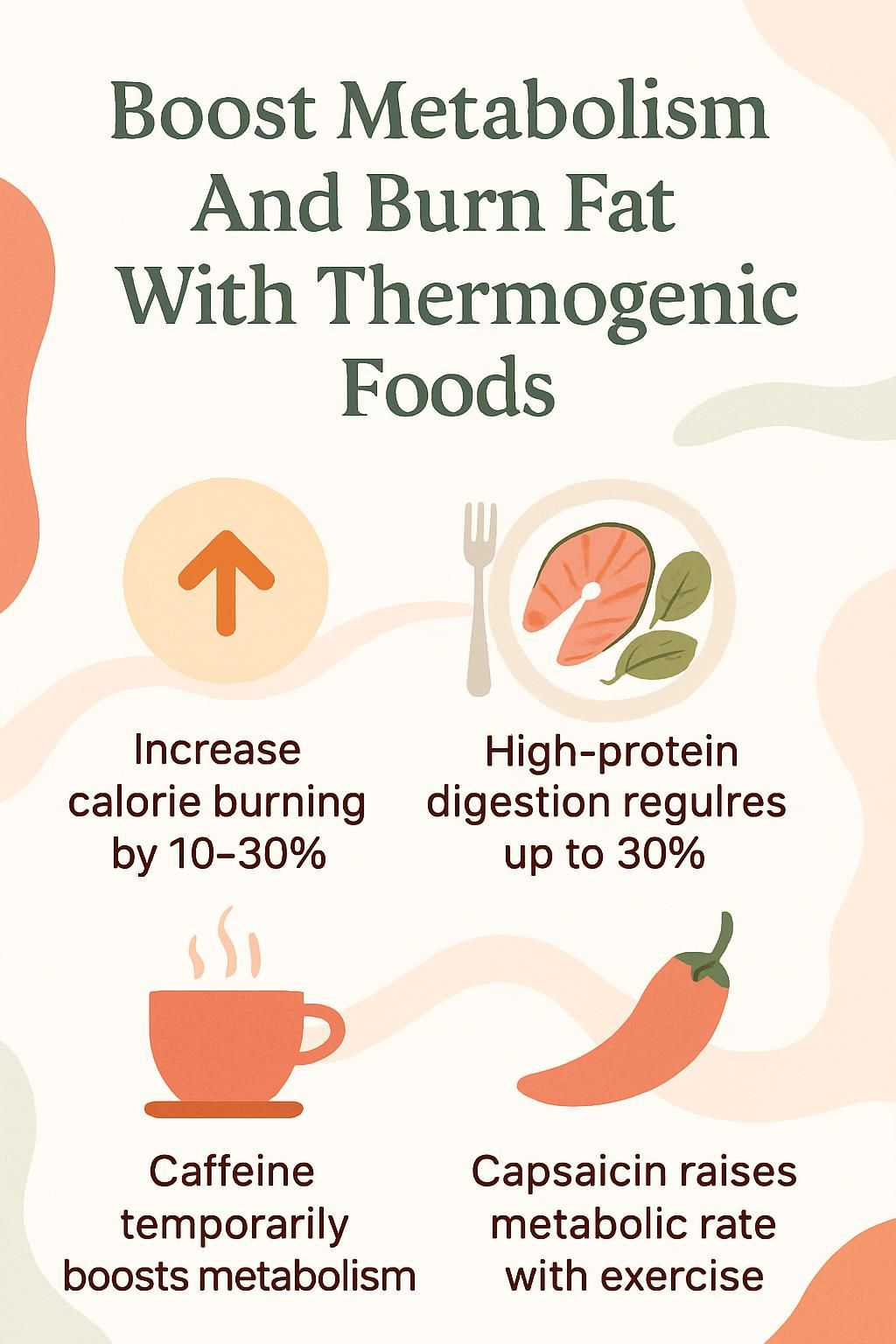Boost Metabolism And Burn Fat With Thermogenic Foods
Our Nutrition Assistant AI Suite will transform your body. You will lose fat, get toned, and build muscle. Gain confidence and optimal health.
Struggling with stubborn belly fat can feel exhausting. Thermogenic foods can help you burn more calories because your body uses extra energy to digest them. These foods and drinks give your metabolism, the rate your body burns calories, a gentle push.
This guide explains how specific healthy foods, beverages, and habits support weight management. You will see what is backed by research and what is hype. Learn which thermogenic foods can make a real difference in your weight loss journey.
Key Takeaways
- Thermogenic foods such as chili peppers, green tea, and lean proteins raise calorie burning during digestion. Studies suggest a 10 to 30 percent boost in energy use after meals.
- Protein has the highest thermic effect. About 15 to 30 percent of protein calories are used to digest it, compared to 5 to 10 percent for carbohydrate and 0 to 3 percent for fat.
- Green tea and coffee contain caffeine that can increase metabolic rate for a short time. Green tea also supplies catechins that support fat oxidation.
- Capsaicin from spicy peppers can raise metabolic rate. Best results come when you pair spicy foods with exercise and a healthy diet.
- Exercise, 7 to 9 hours of sleep, and steady hydration support metabolism. Poor sleep can lower metabolic rate and increase hunger signals.

What are thermogenic foods?

Thermogenic foods are foods that increase energy expenditure during digestion and absorption. This effect is called thermogenesis. It slightly raises your internal temperature and makes your body burn more calories for a short period.
Examples include chili peppers with capsaicin, green tea rich in catechins, coffee with caffeine, and spices like ginger and cinnamon. These compounds activate the nervous system and encourage a temporary rise in metabolic rate.
Research reported in The American Journal of Clinical Nutrition shows that protein rich foods such as chicken and fish can raise metabolism more than carbohydrate or fat. Protein has the highest thermic effect of the macronutrients.
Spicy meals can make you sweat because they stimulate thermogenesis.
I began adding extra pepper and ginger to my morning eggs after reading about capsaicin and metabolism. Within a week, workouts felt warmer and energy stayed steadier through the afternoon.
Thermogenic foods work best alongside regular physical activity and a balanced diet. People who are sensitive to caffeine or capsaicin should start small and monitor symptoms.
How do thermogenic foods boost metabolism?
Thermogenic foods help boost your metabolism by making your body spend more energy during digestion. That extra energy burn can support fat loss over time when combined with smart eating and movement.
What is the thermic effect of food?
The thermic effect of food, or TEF, is the energy your body uses to digest, absorb, and store nutrients. After a meal, metabolic rate can rise by 10 to 15 percent, sometimes more, depending on what you eat.
- Protein: about 15 to 30 percent of calories used for digestion
- Carbohydrate: about 5 to 10 percent
- Fat: about 0 to 3 percent
Choosing higher protein foods like chicken, beans, or seafood increases TEF. That means your body will burn more calories as it processes those nutrients. Time of day matters too. TEF is often higher in the morning than at night.
Fiber helps as well. Studies in The American Journal of Clinical Nutrition suggest that eating 35 to 45 grams of fiber daily for several weeks can increase calorie burning after meals.
How do thermogenic foods increase energy expenditure?
Thermogenic foods make your body work harder during digestion, which increases energy expenditure. Capsaicin from chili peppers, jalapeños, and paprika can raise metabolic rate and support fat burning in the hours after a meal.
Protein sources like chicken, fish, eggs, and lentils require more energy to digest than fat or carbohydrate. Your body uses extra calories to break down and process amino acids, a dynamic sometimes called specific dynamic action.
Medium chain triglycerides in coconut oil are absorbed quickly and can be used for energy, which may nudge metabolism higher. Caffeine from green tea and coffee provides a short-term rise in energy use. Green tea also contains EGCG, a catechin that appears to work with caffeine to support fat oxidation.
After spicy meals or a cup of green tea, many people notice a slight warmth and more alertness. Those changes signal a small uptick in energy expenditure.
How do thermogenic foods promote fat burning?
Fat burning, also called fat oxidation, increases when thermogenesis rises. Spicy peppers that contain capsaicin can lift body temperature briefly. That heat effect uses more calories.
Green tea and matcha supply both caffeine and catechins. Together they encourage your body to break down stored fat more efficiently. Turmeric provides curcumin, which may support higher energy use during activity.
Garlic has compounds such as allicin that may support metabolic health. Some people include a small raw clove in meals, though cooked garlic is easier on the stomach. Fresh ginger contains gingerol, which may aid thermogenesis and digestion.
Cinnamon contains cinnamaldehyde. Up to 6 grams a day has been studied for metabolic support. Coffee and cocoa contribute caffeine and theobromine, two compounds that can support thermogenesis in the short term.
Coconut oil provides medium chain fats that are quickly turned into energy. That shift can increase fat burning and may reduce appetite in some people.
Top thermogenic foods to include in your diet
Add a handful of these foods to meals and snacks. Small daily changes add up over time.
Lean animal proteins
Lean meats like chicken and turkey have a high thermic effect. Your body burns more calories digesting them compared with foods higher in fat. Protein also improves satiety, which helps you eat fewer calories without feeling deprived.
Choose grilled or broiled options and trim visible fat. Low fat cottage cheese and yogurt deliver protein with fewer calories and minimal saturated fat. Low fat milk supplies calcium and vitamin D that help maintain muscle mass, which keeps basal metabolic rate higher.
The American Heart Association supports including lean proteins as part of weight management. Meals built around grilled chicken with vegetables often keep hunger away longer than pasta dishes high in refined starch.
Plant-based proteins
Plant proteins also raise TEF compared with fat or sugar. Lentils, beans, and tofu pack fiber, iron, magnesium, and potassium. One cup of cooked lentils provides about a third of your daily iron needs.
Add lentils to soups, salads, or grain bowls for steady energy. Almonds and other nuts provide healthy fat plus protein and fiber, which can support appetite control. Buy beans in bulk or choose low sodium canned versions for quick meal prep.
I often add chickpeas to a salad at lunch. Energy stays steady and afternoon snacking drops.
Fish and seafood
Fatty fish such as salmon, tuna, sardines, and mackerel supply protein and omega 3 fats. Digesting seafood requires meaningful energy, which raises calorie burn after meals. The American Heart Association suggests eating fish twice a week.
Seafood also provides iron, zinc, and selenium to support thyroid function. Shellfish and lean fish like cod help preserve muscle mass during weight loss. If fresh fish is hard to find, omega 3 supplements are an option, though food first is ideal.
Chili peppers and foods with capsaicin
Chili peppers, jalapeños, and paprika contain capsaicin, a compound that can boost energy expenditure for a short time. Use sliced chilis in stir fries, salsa, or salads. Start light if you are sensitive to heat.
Capsaicin may also help with satiety, which supports calorie restriction when needed. Avoid spicy foods if you have reflux, ulcers, or hemorrhoids. The strongest results appear when capsaicin is combined with other thermogenic foods and exercise.
Green tea and matcha tea
Green tea provides catechins, especially EGCG, plus caffeine. This duo can raise metabolic rate and support fat oxidation. Many people do well with up to four cups per day. Those with high blood pressure may prefer three cups or less.
Matcha contains more caffeine and catechins per cup than regular green tea. Limit matcha to three cups daily to avoid too much caffeine. These teas are not advised for children, people who are pregnant or breastfeeding, or those with kidney, liver, or thyroid disease without medical guidance.
I began drinking matcha before strength training, and energy during sets improved. Hunger after the workout was also lower.
Coffee
Coffee’s caffeine can lift metabolic rate and increase calorie burn for a few hours. Plain black coffee is best for these effects. Many adults can tolerate up to 400 milligrams of caffeine per day, roughly two to three cups.
People who are pregnant should limit caffeine to about 200 milligrams per day. Coffee is not suitable for children or for those with anxiety, insomnia, reflux, or active ulcers. Swapping sweetened drinks for black coffee helped me feel more alert and less hungry while dieting.
Ginger
Ginger contains gingerol, which may support thermogenesis and digestion. Use fresh or powdered ginger in stir fries, smoothies, or tea. Evidence in humans is mixed, yet many people find ginger helpful for comfort and warmth.
Avoid large amounts if you have gallstones, bleeding disorders, or take blood thinners. During pregnancy, keep intake modest unless your clinician approves more.
Cinnamon
Cinnamon contains cinnamaldehyde, a compound studied for metabolic support. Up to 6 grams per day has been tested in research. Sprinkle cinnamon on oatmeal, yogurt, or fruit for added flavor without extra sugar.
People with gastritis, ulcers, or those taking diabetes or heart medicines should check with a clinician before using large amounts. Mixing cinnamon into Greek yogurt helped me stay full longer before lunch.
Turmeric also offers useful thermogenic effects.
Turmeric
Turmeric provides curcumin, which may support thermoregulation and fat oxidation. Add it to curries, roasted vegetables, or a warm milk drink. Pair turmeric with a pinch of black pepper. Piperine in pepper helps your body absorb curcumin.
Avoid high doses if you have gallstones or use anticoagulant medications. People who are pregnant or breastfeeding should talk with a healthcare professional first.
Garlic
Garlic contains allicin and related compounds that may support metabolic health. Some people use one small raw clove daily, though cooked garlic is easier on digestion. Garlic can raise the thermic effect of food slightly, which increases energy use after meals.
Avoid garlic if you have low blood pressure, stomach pain, or take blood thinners like warfarin. Use care during pregnancy or breastfeeding and talk with a clinician if unsure.
Additional thermogenic foods and drinks
These options can boost energy use and support appetite control. Choose the ones that fit your routine and health needs.
Coconut oil
Coconut oil contains medium chain triglycerides, or MCTs. Your body absorbs MCTs quickly and often uses them for energy. That process can raise calorie burn slightly.
Studies suggest up to two tablespoons per day may support these effects. Use coconut oil in cooking or stir a small amount into coffee. Keep portions moderate since excess may raise LDL cholesterol and cause stomach upset.
I added a teaspoon to morning coffee for a month. Midday hunger eased a bit, which made sticking to lunch plans easier.
Guarana powder
Guarana is rich in caffeine and plant compounds that can raise metabolic rate for a short time. Limit guarana powder to 2 grams per day and mix it into smoothies or yogurt.
Avoid guarana if you have high blood pressure, heart conditions, kidney disease, epilepsy, or anxiety. It is not advised during pregnancy or breastfeeding. Talk with your healthcare provider before starting any new supplement.
Hibiscus tea
Hibiscus tea is caffeine free yet still supports thermogenesis. It contains catechins, flavonoids, and anthocyanins that help increase energy use and support fat oxidation.
Drink up to three cups per day after meals. Avoid hibiscus tea during pregnancy, breastfeeding, or if you have kidney or liver disease unless a clinician approves it.
Yerba mate
Yerba mate is a high caffeine tea enjoyed across South America. Its caffeine content acts as a thermogenic agent, which can boost calorie burn and alertness for a few hours.
Limit intake to about 1.5 liters per day to keep caffeine in a safe range. Yerba mate is not suitable for children, people with anxiety or insomnia, or during pregnancy. Enjoy it hot or cold.
Low-fat dairy products
Low fat milk, yogurt, and cottage cheese provide protein, calcium, and vitamin D. These nutrients help preserve muscle, which supports a higher basal metabolic rate. Dairy products also offer iodine and selenium for thyroid health.
Choose unsweetened, low fat options for the best results. For a quick snack, mix cottage cheese with berries. After workouts, a serving of low fat yogurt can steady hunger and energy.
Berries
Berries like blueberries and strawberries are rich in fiber and antioxidants, yet low in calories. Fiber increases fullness and helps you manage appetite between meals.
Antioxidants support cell health and may enhance the thermic effect of food. Add berries to oatmeal or yogurt. One cup of strawberries offers about three grams of fiber, enough to help you stay satisfied longer.
Key nutrients that support thermogenesis
Some nutrients help your body produce energy efficiently. Including them regularly can support a steady metabolic rate.
Iron, zinc, and selenium-rich foods
Iron, zinc, and selenium support thyroid hormones and energy metabolism. Good sources include lean meats, poultry, seafood, legumes, nuts, and dairy products.
One cup of lentils provides about 35 percent of your daily iron needs. Seafood and dairy deliver selenium. Red meat and beans supply both iron and zinc. A varied diet helps prevent shortages that can slow metabolic rate.
Iodine-rich foods
Iodine is essential for thyroid hormone production. Seaweed, dairy, eggs, shellfish, tofu, and tempeh provide iodine along with protein. Aim for balance. Too little iodine can lower metabolism, while excessive iodine may disrupt thyroid function.
Including iodine rich choices alongside thermogenic foods helps your body manage energy use safely.
Antioxidants and catechins
Antioxidants protect cells and support efficient energy production. Catechins, such as EGCG in green tea and matcha, can increase fat oxidation after meals. Hibiscus tea provides anthocyanins and other helpful compounds. Cocoa offers antioxidants and theobromine.
Berries add a wide range of antioxidants that support metabolic health. A variety of these foods across the week is a practical goal.
Medium-chain triglycerides (MCTs)
MCTs are medium chain fats found in coconut oil. They are absorbed quickly and often used for immediate energy. That pathway can increase calorie burn and may improve satiety.
Many people use up to two tablespoons per day in cooking or coffee. When I added a small amount of MCT oil to smoothies, energy felt steadier during busy mornings.
Lifestyle tips to enhance metabolism further
Your daily habits matter as much as the food you eat. A few steady practices can magnify the benefits of thermogenic foods.
How does regular exercise and strength training help metabolism?
Exercise burns calories during the activity and after you stop because of the afterburn effect, called excess post exercise oxygen consumption. High intensity intervals tend to produce the largest afterburn.
Muscle tissue uses more energy at rest than fat tissue. Strength training helps you build and preserve muscle, which raises your daily calorie burn. I saw better energy and easier weight control after I paired strength workouts with thermogenic meals.
Build a plan that fits your fitness level. If you have health concerns, ask your clinician for guidance before you start.
Why is getting enough sleep important for metabolism?
Adults need 7 to 9 hours of sleep each night. Short sleep disrupts how your body handles calories and can reduce the thermic effect of food. It also makes high fat meals feel less satisfying, which can lead to overeating.
Quality sleep keeps hunger hormones in balance and supports steady energy use. Set a consistent bedtime, dim screens at night, and keep your room cool and dark.
How does staying hydrated support metabolism?
Even mild dehydration can slow calorie burning. Drinking water before meals may reduce appetite and support better food choices. Cold water can cause a tiny uptick in energy use as your body warms it.
Hydration also supports digestion, which helps your body handle protein efficiently. Aim to sip water across the day. Unsweetened tea, such as green tea or hibiscus tea, can count toward your fluids. Some people also enjoy a small amount of apple cider vinegar mixed with water, although it is not a thermogenic food by itself.
Common myths about thermogenic foods
Thermogenesis is helpful, yet some common claims go beyond the science. Here is what research supports today.
What is the truth about negative-calorie foods?
Negative calorie foods, like celery, are said to take more energy to digest than they provide. Evidence does not support this claim. TEF accounts for about 5 to 15 percent of daily calorie use, not a net loss.
High water and high fiber foods can increase fullness and aid weight control. They do not make your body burn more calories than you consume. Celery and berries are useful, just not magic.
Are some thermogenic foods more effective than others?
Yes. Protein rich foods and capsaicin rich spices show stronger effects on TEF than most other options. A breakfast with chicken sausage or tofu and a sprinkle of chili flakes will burn more digestion related calories than a meal of white bread and jam.
Green tea, turmeric, garlic, ginger, and guarana have benefits, though their effects are usually smaller than protein or chili peppers. Meal timing matters too. TEF tends to be higher in the morning.
I noticed better focus and fewer cravings when I added lean fish and a bit of chili to breakfast. Your experience may vary, so adjust to what you tolerate well.
How to incorporate thermogenic foods into your diet
Make simple swaps at meals and snacks. Consistency beats perfection, especially early on.
How can you create balanced meals with thermogenic foods?
Start meals with fiber rich foods like berries, vegetables, or whole grains. Pair them with lean protein such as grilled chicken, tofu, or seared fish. Protein raises the thermic effect of food and improves satiety.
Add flavor and heat with chili peppers or garlic. Sip green tea, coffee, or hibiscus tea with meals if you tolerate them. Cook with a small amount of coconut oil when it fits your plan. Drink water through the day to support digestion and appetite control.
What are some meal prep ideas using thermogenic foods?
Grill chicken or turkey for quick lunches. Add brown rice, roasted vegetables, and a dash of turmeric or ginger. Build a quinoa bowl with black beans, spinach, bell peppers, sliced chili, and a garlic turmeric dressing.
Make overnight oats with low fat dairy or Greek yogurt, cinnamon, and berries. Brew green tea or matcha to enjoy with meals. Bake salmon or cod with crushed garlic and a pinch of cayenne. Steam broccoli or cauliflower and toss with a teaspoon of coconut oil.
For snacks, portion hard boiled eggs or sliced turkey with baby carrots and hummus. Stir in cumin or paprika for extra warmth.
What are healthy snack options with thermogenic benefits?
Choose fiber rich snacks that keep you full:
- Almonds, pistachios, or a small apple with peanut butter
- Low fat Greek yogurt with cinnamon and berries
- Chickpeas or edamame with sea salt and chili flakes
- Tuna packets, salmon bites, or turkey slices for quick protein
- Green tea or black coffee for a light energy lift
If you take prescription medicines such as MAOIs, including phenelzine, tranylcypromine, isocarboxazid, selegiline, or moclobemide, ask your clinician about caffeine and herbal products before changing your routine.
Conclusion
Thermogenic foods can boost your metabolism and help you burn fat, especially when combined with smart habits. Lean proteins, spicy peppers, green tea, and fiber rich foods raise calorie burn during digestion and improve satiety.
Pair these foods with regular exercise, steady hydration, and 7 to 9 hours of sleep for the best results. If you have medical conditions or are pregnant, talk with a healthcare professional before making big changes. Small daily choices, done consistently, can move your weight management forward and support your health.
FAQs
1. What are thermogenic foods and how do they help overall health?
Thermogenic foods increase the body’s heat production, which can boost metabolism. This process helps burn more calories and may support fat loss. Eating these foods as part of a balanced diet can contribute to better overall health.
2. Which thermogenic foods are most effective for boosting metabolism?
Foods like chili peppers, green tea, ginger, and protein-rich items have shown thermogenic effects in studies. For example, research published in the American Journal of Clinical Nutrition found that capsaicin from chili peppers increased calorie burning by about 50 calories per day (Lejeune et al., 2003). Including these foods regularly may help improve metabolic rate and support overall health.
3. Is there scientific evidence supporting the use of thermogenic foods for fat loss?
Several studies suggest that thermogenic foods can aid fat loss when combined with healthy eating habits and exercise. A review in Obesity Reviews reported that green tea extract led to greater weight reduction compared to placebo groups (Hursel et al., 2009). These findings highlight how certain foods can play a role in improving overall health through enhanced metabolism.
4. How have people used thermogenic foods to improve their own health?
Many individuals add spices like cayenne or drink green tea daily as part of their routine. In my experience, adding ginger tea before meals helped me feel fuller and more energetic throughout the day. Simple changes like this can make it easier to maintain healthy habits while supporting overall health goals.
Summary: Thermogenic foods such as chili peppers, green tea, ginger, and high-protein options may help boost metabolism and promote fat burning according to credible research. Regularly including these items supports both weight management efforts and long-term overall health improvements.







